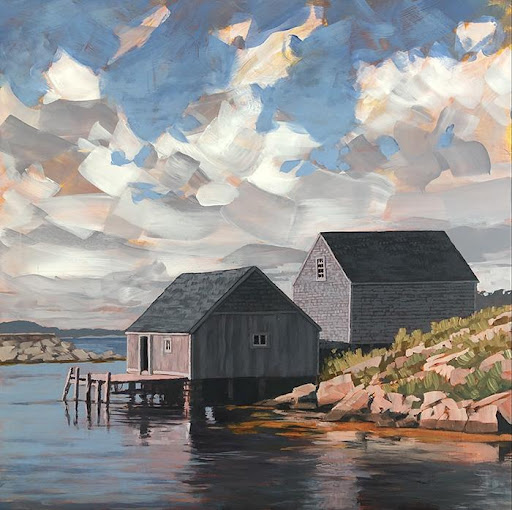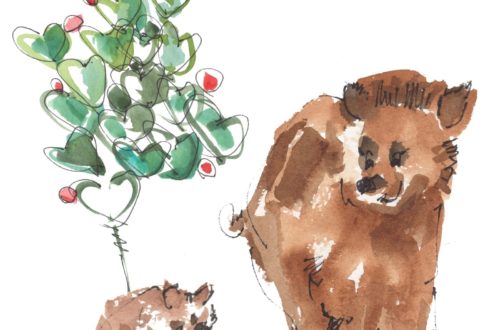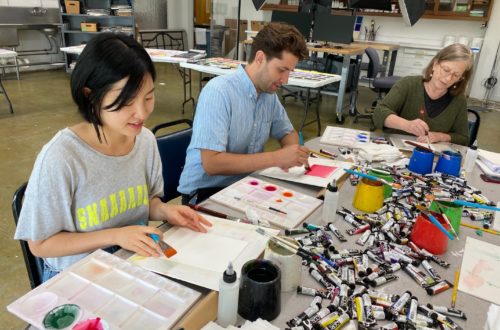After what started out as a peaceful hobby, Claybord artist Jim Musil has found much success sharing his paintings on social media.

Q: Your mother was an artist. Did she encourage you to become an artist, or did she prefer you work towards a 9-5 career?
A little of both actually. She encouraged me to be artistic at every step, but she didn’t think art would be a career I could rely on. That didn’t seem discouraging to me, just pragmatic. The University of Minnesota had a great program in which you could design your own major, so I ended up building something that fit my passions – studio art and computer science. In my mind, the two aren’t really that different. Most people assume that the artistic side of my brain helps me be a better technologist, but being fluent in technology has been extremely helpful navigating all the changes that have occurred in the art world over the last 5-10 years.

Q: You studied art in college but decided on a tech career. What made you pick up a paintbrush again?
I love my tech career, and I’m good at it, but I always knew I would have a second life as an artist. My family and I spent a great year living in Costa Rica that really changed my outlook on so many things. When I came back, I just didn’t want to go back to doing what I had been doing. One night I was bored while we were all sitting around watching tv and I realized I could just as easily sketch at the same time. Sketching turned to painting, and it’s just sort of taken over from there.

Q: You have a distinct style. Tell us a bit about your painting process.
My favorite thing about painting is that there’s no right way to do it. Every artist should have their own priorities that matter most to them. Mine are color, mood, and movement. I like to paint real places and things, but I don’t particularly care how accurate or realistic they are. In fact, I take it as a failure when someone says, “I thought it was a photo at first!” I want you to know it’s a painting. I want you to see my hand. I paint with fast, loose strokes adding only as much detail as I need to get the point across. I like to use brighter colors because that’s how my mind stores an image in my memories.

Q: Water and sky are prevalent in your pieces. Do you prefer painting one over the other?
Skies for sure. I like to paint a lot of different things that have meaning to me, but they are almost always anchored by a sky.

Q: Do you paint from photographs or life?
I use photographs mainly to stitch together compositions, but I stop looking at them pretty quickly into a painting. It’s easy to get lost in meaningless detail if I use the photo as a reference for too long. A painting needs to be its own thing. I enjoy painting from life, but there’s so many subjects I want to paint that are too temporary or physically difficult to paint on site. Sunsets last 10 minutes – and the moment I’m trying to capture might be only 1 minute. Hats off to those plein air painters that do that. It’s just not my priority.

Q: Your use of color is as impressive as your artwork. Do you have favorite colors that you like to work with?
Like a lot of new painters, I went out and bought a giant set of paints with a wide spectrum of different colors. As time has passed, I’ve migrated to a much simpler primary palette along with a black and a white. For example, I have about a dozen barely used bottles of different green hues, but I’ve found it works better to just mix a little yellow and black. The most important color I use is probably Quinacridone/Nickel Azo Gold from Golden. I use this for my underpainting. Because I paint with loose strokes, scumbling, and glazes, this red/orange/yellow color has a big influence over everything that comes on top of it.

Q: What do you love most about Ampersand Claybord for your acrylic work?
I fell in love with Claybord panels when I was messing around with the traditional Egg Tempera technique, which really demands a smooth rigid support. I really appreciate how they feel. I moved on from Egg Tempera (partially because my dog kept licking my paintings), but Claybord panels stuck around as my preferred choice working with acrylics. The clay surface is smooth, but it’s also absorbent, which allows the colors to sink in a bit. They are also simple to ship and easy to store.

Artist Bio:
Jim Musil grew up in western South Dakota. He graduated from the University of Minnesota in 1998 with a degree in Studio Arts and Computer Science. Despite a successful career in technology, he returned to painting in 2017. Jim now produces about 1-2 new paintings each week. His subjects usually involve the natural world, but often include a hint that humans are there, too. To see more of Jim’s work, visit his website, Instagram, and Facebook.






